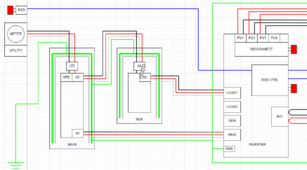skyking1
Solar Enthusiast
I have been reading other threads with a 'critical loads" search.
My initial deployment is 5~8Kw of roof mounted panels, depending on the roof real estate I have.
My goals are to have a minimal critical loads subpanel that can be backed up with an inverter and batteries.
I can keep that load down to 240V@50A, a 6 space box with (4) 15A 120V breakers and a pair of 20's.
That is the breakered load, the actual loads during a power outage would be much less. (Turn off the lights when not in the room, etc. )
Originally I was thinking of microinverters for the built in RSD feature, but the backup aspect may be better served with a string inverter/charger.
I may be wrong on that and would welcome any input.
I will get a net metering agreement and it's a 1:1 with banking from March to March, so there is no advantage for running off the battery bank. I just want the lights to work and the food to not spoil, and my hydronic pumps to work in an outage.
If we are away and all the lights are off, the refrigerator and freezer loads won't be much draw and it could go for days if I prep to keep the loads low.
My initial deployment is 5~8Kw of roof mounted panels, depending on the roof real estate I have.
My goals are to have a minimal critical loads subpanel that can be backed up with an inverter and batteries.
I can keep that load down to 240V@50A, a 6 space box with (4) 15A 120V breakers and a pair of 20's.
That is the breakered load, the actual loads during a power outage would be much less. (Turn off the lights when not in the room, etc. )
Originally I was thinking of microinverters for the built in RSD feature, but the backup aspect may be better served with a string inverter/charger.
I may be wrong on that and would welcome any input.
I will get a net metering agreement and it's a 1:1 with banking from March to March, so there is no advantage for running off the battery bank. I just want the lights to work and the food to not spoil, and my hydronic pumps to work in an outage.
If we are away and all the lights are off, the refrigerator and freezer loads won't be much draw and it could go for days if I prep to keep the loads low.





